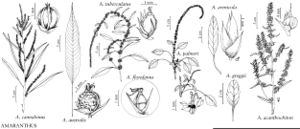Difference between revisions of "Amaranthus acanthochiton"
Madroño 13: 44. 1955.
FNA>Volume Importer |
FNA>Volume Importer |
Revision as of 22:26, 16 December 2019
Plants glabrous or glabrescent. Stems erect, much-branched, 0.1–0.8 m; proximal branches ascending. Leaves: petiole shorter than blade; blade narrowly linear-lanceolate to linear, 2–8 × 0.2–1.2(–1.7) cm, base narrowly cuneate to narrowly decurrent, margins erose, crispate, or irregularly undulate, apex acute to subobtuse. Inflorescences terminal spikes, erect, usually stiff. Bracts completely enfolding flower; of pistillate flowers with prominent excurrent midrib, venation distinct, broadly triangular to deltate, 5+ mm, longer than tepals, margins erose, crenate, or denticulate, apex acute or acuminate; of staminate flowers shorter than tepals, apex acute. Pistillate flowers: outer tepals rudimentary, less that 1.2 mm; inner tepals with venation distinct, 3–4(–5) mm, apex acute, with terminal mucro; style branches spreading; stigmas 3. Staminate flowers: tepals 5, equal or subequal, 2–3 mm, margins erose to denticulate, outer tepals with apex subobtuse to acute-acuminate; inner tepals with apex distinctly acuminate or mucronulate; stamens 5. Utricles light brown, elliptic to obovate-elliptic, 2(–2.5) mm, shorter than outer tepals, slightly rugose to smooth. Seeds dark reddish brown to brown, 1–1.3 mm diam., shiny.
Phenology: Flowering summer–fall.
Habitat: Sandy areas, sand dunes, riverbanks, disturbed habitats
Elevation: 1000-2000 m
Distribution
Ariz., N.Mex., Tex., Utah, n Mexico (Chihuahua).
Discussion
Amaranthus acanthochiton is very different morphologically from other taxa of dioecious amaranths. In its vegetative and floral morphology, it is similar to the monoecious A. fimbriatus, especially in branching habit, narrow linear to linear-lanceolate leaf blade, and broadly spatulate to almost fan-shaped tepals of the pistillate flowers. These species are also similar phytogeographically, occurring within the southwestern part of the United States and neighboring northern Mexico. The “dioecious amaranths” are an artificial and polyphyletic group consisting of at least two (or three) independently evolved lineages roughly corresponding to the sections of subg. Acnida outlined by S. L. Mosyakin and K. R. Robertson (1996).
Amaranthus acanthochiton is critically imperiled in Utah and imperiled in Arizona; its Global Heritage Status Rank is G5 as defined by The Nature Conservancy. Seeds and young leaves of A. acanthochiton were used by Native Americans (Hopi) as food: the seeds cooked as a kind of porridge, and the leaves cooked and eaten as greens or with meat (D. E. Moerman 1998).
Selected References
None.
